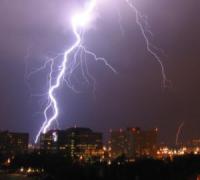One of the most fascinating things a thunderstorm contains is lightning. One never knows when it is going to happen; this brilliant illumination that dances among the clouds. Those bolts of lightning cause an average 80 deaths and 300 injuries in the United States every year.
Just recently, a young pregnant woman was hit by lightning as she exited her car during a thunderstorm to run into a house. She remains in the hospital, but doctors were unable to save her unborn child.
Weather warning devices such as NOAA weather radio furnish information to make the public aware of approaching thunderstorms. The best possible advice is: If you hear thunder, it is time to take precautions.
Places you don’t want to be if this threat occurs:
- Open spaces, such as ball parks, golf courses
- On the water: wading, in a boat, swimming, etc.
- Outside, period
- In the shower or running water
- Talking on a corded telephone
- In a group of people
Do you know:
- Lightning can travel sideways, up to ten miles?
- Lightning can strike someone swimming or scuba diving in water and travel a great distance away from the point of contact?
- That you are safe in a car, as long as you have the windows up and do not touch any metal? Contrary to theory, rubber tires do not offer protection from lightning. The car’s metal conducts the charge to the ground.
- Lightning hits the tallest point? Therefore, if you are outside, crouch as low as possible, and touch as little of the ground as necessary.
- Ten per cent of lightning occurs without visible clouds? Even if the sky is blue, you need to take cover when you hear thunder.
- If the time delay is 30 seconds or less between lightning and thunder, you need to seek shelter immediately?
If someone is struck by lightning:
- Call 9-1-1 for immediate assistance
- Give First Aid
- Check for burns.
- You are not at risk to touch someone who has been hit by lightning; the victim does not carry electric charge that can shock you.
Lightning can cause broken bones, damage to the nervous system, loss of hearing or eyesight. The next time clouds gather, and thunder starts to rumble, play it safe, and stay inside!


